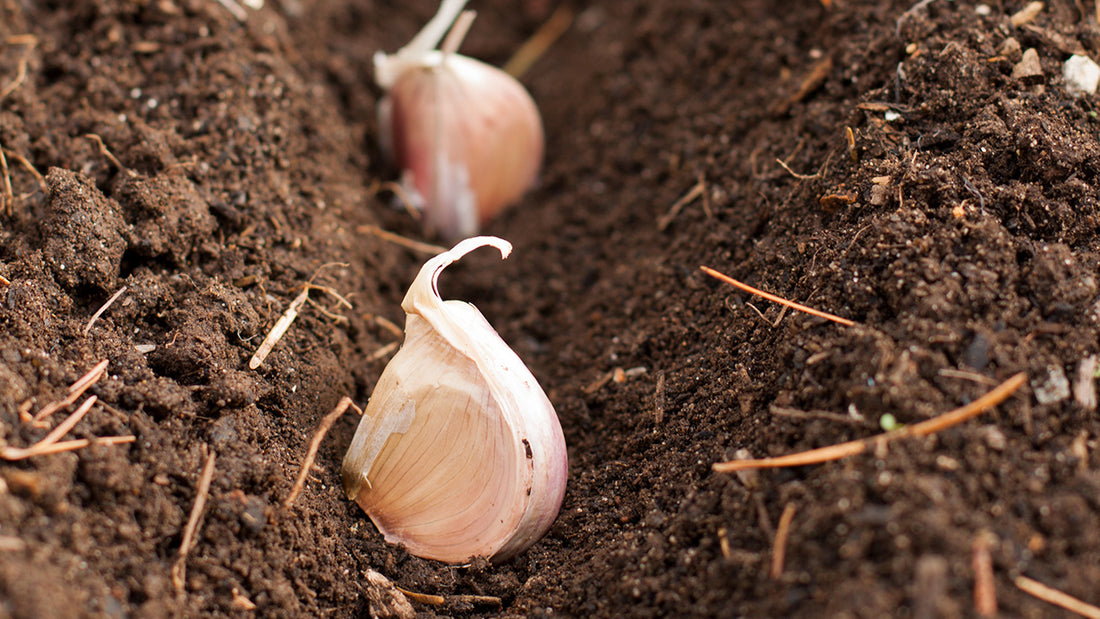How To Prepare Your Garden For A Great Garlic Harvest
Fall is just around the corner and it is time to start thinking about planting seed garlic. Planting large individual garlic cloves will produce larger bulbs, but another consideration should be the soil. Preparing soil for garlic properly is also key to a successful garlic crop the following summer. Watch our video Selecting and Planting Garlic for more information on planting and growing garlic.
Practice Crop Rotation
-
Practicing smart crop rotation should be followed.
-
Make sure you are not planting seed garlic (also onions, shallots or leeks) in the same area every year.
-
Also you should not plant seed garlic next to an area where you are planning to plant beans or peas. Garlic and other alliums seem to stunt the growth of these vegetables.
How to Prepare Soil for Garlic
The best soil for growing seed garlic is sandy loam that is well-drained. If you your soil is clay and tends to have drainage problems, you can plant in raised rows, raised beds (at least 12 inches deep) or even large pots. It is best to get your soil amended with compost and fertilizer before planting.
Step 1: Add Organic Matter

This can be done naturally by using summer cover crops. You can grow a summer cover crop that gets worked back into the soil weeks before the garlic is planted.
- Some great summer soil building mixes are the Peaceful Valley Summer Soil Builder Mix, which is a mix of buckwheat and cowpeas. This requires more pre-planning since it will take about 6-7 weeks for maturation and then a few more weeks for it to break down in the soil.
- Buckwheat is a great plant for quick growth (finished in only 30-45 days) and will actually pull insoluble phosphorus out of the soil which will be released into a plant-available form when it breaks down. If you don't want to grow a cover crop or don't have time, work in quality compost or composted manure to increase the organic matter.
- If you don't have the space or time to plant a cover crop, you can always add compost to the planting area for your seed garlic.
Step 2: Fertilizing
When planting seed garlic in the fall, avoid giving it a high nitrogen fertilizer. The idea is to get the roots established before the plant gets hit by cold temperatures of winter. It is not ideal to have a significant amount of above ground growth before spring, unless you live in an area with milder winters. If this happens, the top growth can be damaged by severe winter temperatures.
Since seed garlic need a good supply of phosphorus for root development, you can work in fertilizers that has higher levels of phosphorus and potassium such as the following:
-
Bone meal
-
Seabird or bat guano that are high phosphorus
- Peaceful Valley Organics Bloom and Bud 0-10-10
Come spring when the seed garlic plants are starting to put out leaves, top dress with fertilizer with a higher amount of nitrogen, like the Bio-Fish, All Purpose, Phyta-Grow Leafy Green Special Fertilizer, blood meal, feather meal, high nitrogen guanos, or fish meal.
Mulching
Mulching is especially important if the seed garlic is planted where cold winters and harsh winters are normal and the ground freezes. Cover with a thick layer of straw to protect the garlic throughout the winter; about 4-6" in very cold regions.
In milder climates a thinner layer is just fine. In the summer the mulch will help conserve water, cut down on weed growth and will help even out fluctuations in soil temperature.
*****
Garlic is easy to grow and you will have a fun time in your home garden! Get your soil ready for planting your fall garlic and grow a great crop of plump garlic bulbs.
Resources
- Growing Garlic in Minnesota
- Plant Garlic in the Fall
- Suggested Type of Garlic: Elephant Garlic for Sale


14 comments
Kayla, If the garlic is not in the same bed as the soybeans, it is probably ok.
Is it safe to plant a garlic patch near a crop field of soybeans?
It says not to plant near peas or beans so just curious if it would have an effect on those types aswell.
Debra, maybe you have too much nitrogen in the soil or extreme temperatures. Does your plant produce flowers? If the temps are too high the flowers can be dropped by the plant.
I have beautiful pole bean vines and NO BEANS! What could have happened?
Miss Maggie, checked your average temps in the winter and you don’t get very cold in Austin. I would advise growing softneck garlic, unless you give the hardneck garlic a cold treatment in the refrigerator.